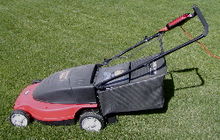Types of lawn mowers
By energy source
Gasoline (petrol)
Most rotary push mowers are powered by internal combustion engines. Such engines are usually four-stroke cycle engines (although a number of older models used two-strokeengines), running on gasoline (petrol) or other liquid fuels. Internal combustion engines used with lawn mowers normally have only one cylinder. Power generally ranges from two to seven horsepower (1.5 to 6.75 kW). The engines are usually carbureted and require a manual pull crank to start them, although electric starting is offered on some models. Some mowers have a throttle control on the handlebar with which the operator can adjust the engine speed. Other mowers have a fixed, pre-set engine speed. Gasoline mowers have the advantages over electric mowers of greater power and distance range. They do create pollution due to the combustion in the engine, and their engines require periodic maintenance such as cleaning or replacement of the spark plug and air filter, and changing the engine oil.
Electricity

Corded rotary lawn mower, with rear grass catcher (note the red cord attached at the handle).

Cordless and rechargeable rotary lawn mower, in mulch mode, removable battery located above rear wheels
Electric mowers are further subdivided into corded and cordless electric models. Both are relatively quiet, typically producing less than 75 decibels, while a gasoline lawn mower can be as loud as 95 decibels or more.
Corded electric mowers are limited in range by their trailing power cord, which may limit their use with lawns extending outward more than 100–150 feet (30–45 m) from the nearest available power outlet. There is the additional hazard with these machines of accidentally mowing over the power cable, which stops the mower and may put users at risk of receiving a dangerous electric shock. Installing a residual-current device (GFCI) on the outlet may reduce the shock risk. On the United States market as of summer 2008, a corded electric mower from a respectable manufacturer costs about the same as an entry-level internal-combustion mower ($150–200), with significantly higher reliability, significantly lower cost of ownership, and a significantly reduced carbon footprint.
Cordless electric mowers are powered by a variable number (typically 1-4) of 12-volt rechargeable batteries. Typically more batteries mean more run time and/or power. Batteries can be in the interior of the lawn mower or on the outside. If on the outside the drained batteries can be replaced with recharged batteries. Cordless mowers have the maneuverability of a gasoline powered mower and the environmental friendliness of a corded electric mower, but are more expensive and come in fewer models (particularly self-propelling) than either. Disposal of worn-out batteries may negate the environmental advantages, and the motors in cordless mowers tend to be less powerful than gasoline motors of the same total weight (including batteries).
Related Articles:
Different Types of lawn mowers - By rotation
Types of Lawn Mowers - Riding Mower etc.





